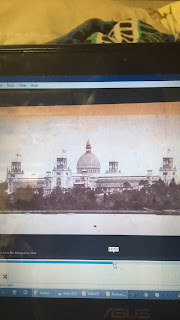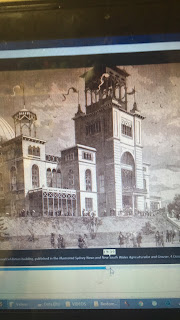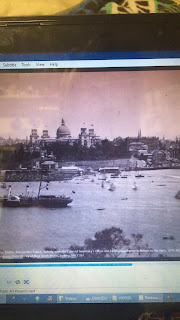Hyde Park Barracks - Queens Square - Macquarie Street.
Built - 1817 - 1819
Architect - Francis Greenway
Hyde Park Barracks & The Government Horse Stables Located Near Government House On Macquarie Street Were The Two Great Accomplishments Of Francis Greenways Work Under The Authority Of Governor Macqaurie.
When Commissioner Bigge Arrived In Sydney In 1820 To Conduct His Investigation Of Governor Macquarie & What Was Going On With The Emancipast Reform In The Colony. The Two Buildings Which Threw The Most Anger At Colonial Government Decadence Was The Government Horse Stables Which Was Close
Hyde Park Barracks Is One Of Only 2 World Heritage Sites In Central Sydney. The Hyde Park Barracks Was Built By Convicts, For Convicts.
It Was Designed & Built By Francis Greenway Who Was Appointed The Colony's First Civil Architect By Governor Lachlan Macquarie In 1816.
It Only Took 2 Years to complete & Became The Centre Of Convict Administration & The Colony's Principal Convict Barracks, With An Estimated 50,000 Prisoners Passing Through It's Gates Between 1819 & 1848
After Transportation Was Abolished in 1848, Hyde Park Barracks Became Sydney's Female Immigration Depot, & Then An Asylum for The Aged & Destitute, & It Provided Shelter For Approx 50,000 Women & Their Children Until 1887. It Then Became A Legal Hub, Housing Complex Courts & Government Offices.
The Heritage Value Of Hyde Park Barracks Was Finally Recognised In 1981 With Protection Under The NSW Heritage Act 1977, & in 1984, The Museum of Applied Arts & Sciences Transformed It Into A Museum.
Hyde Park Barracks Was Designed By Francis Greenway, & Was The Main Barracks That The Convicts Would be Housed In.
It Was Officially Ooened On June 4th 1819 By Governor Lachlan Macquarie
What would Francis Greenway, a perfectionist, have thought of the hideous jumble of buildings that has been allowed to spoil the symmetry of the Barricks now queen square?
If the modern rubbish is ever cleared away from the buildings we shall be able to appreciate the imagination of 18th-century men who could bestow dignity even on a prison.
The male convict Barricks, began in 1817 and finished the following year, would house up to 1000 felons in large dormitories. This was a Macqaurie’s scheme for ridding the town of gangs of convicts turned loose at night.
After their days labour on government works they slept where they could, an extra ordinary system that led to robbery and violence; Some of the convicts even used hire pistols for a night marauding.
Greenways three stories Barricks are one of his best work. The Sydney Gazette Of the day called it
“a noble structure executed comfortably with the most elegant proportions of the Greek school”
Macqaurie was so pleased that he gave Greenway His Full pardon. He Arranged for the building to have a handsome clock-since replaced –
And gave the craftsman that made it a grant of 500 acres.
From the 1840’s to the 1880s the main part of the Barricks with used to lodge newly arrived immigrant women from the British Isles.
A district court was squeezed into one corner, and room was later made for the institution for ageD females. The law officers who finally took over the building are mainly to blame for its present sorry appearance.
Female immigration depot
Hyde Park barracks, a former convict dormitory, was adapted in 1848 as Sydney’s female immigration depot to, to protect and process women arriving in the colony under various government schemes.
Up until 1886, thousands of impoverished working class women were housed here, some with their children, before starting new lives in Australia.
A contemporary monument in the compound wall commemorates the many Irish immigrants and workhouse girls who came to New South Wales fleeing the Irish famine.
Hyde Park Barracks is a historic site located in Sydney, Australia, and is recognized as a UNESCO World Heritage Site. It has a rich history and has served various functions over the years. Here's an overview of the history of Hyde Park Barracks:
Construction and Purpose:
- Hyde Park Barracks was designed by architect Francis Greenway and completed in 1819.
- It was built to accommodate male convicts who were assigned to government labor and needed housing in Sydney.
Convict Accommodation:
- The barracks provided accommodation for convicts who were assigned to various government projects and labor, such as building roads, bridges, and other infrastructure.
- It played a significant role in the convict system of the early colonial period.
Design and Layout:
- The building's design is in the Georgian architectural style and features a long and symmetrical facade.
- It consists of three floors with rooms that were used for sleeping and communal spaces.
Overcrowding and Changes:
- Over the years, the barracks became overcrowded, and the conditions for the convicts were often harsh.
- In the mid-19th century, the building's use shifted to house immigrant women and girls, known as "female immigration depot."
Adaptations and Uses:
- In the late 19th century, the building was used for various purposes, including a courthouse and government offices.
- It was also used as a part of the university and a repository for legal documents.
Preservation and Restoration:
- In the 20th century, efforts were made to preserve Hyde Park Barracks as a historic site.
- The building underwent restoration to bring it closer to its original appearance during the convict era.
World Heritage Status:
- In 2010, Hyde Park Barracks was inscribed as a UNESCO World Heritage Site as part of the "Australian Convict Sites" World Heritage property.
Museum and Interpretive Center:
- Today, Hyde Park Barracks operates as a museum and interpretive center that provides insights into the lives of convicts, immigrants, and the building's historical context.
- It offers visitors a chance to learn about the experiences of those who lived and worked within its walls.
Hyde Park Barracks is not only a historic building but also a place of education and reflection, offering a glimpse into Australia's colonial history and the lives of those who shaped the nation's development

























